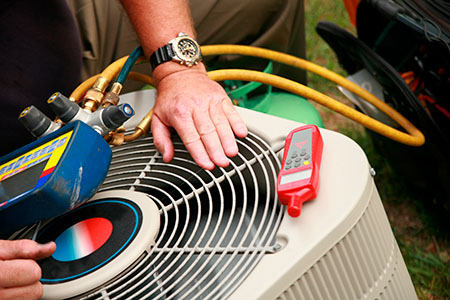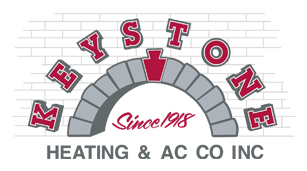Air Conditioner Repair

If a home's air conditioning system is not working up to expectations or failing to provide proper cooling, contact Racine and Kenosha's trusted heating and cooling repair specialists - Keystone Heating & AC. Our HVAC technicians offer air conditioning repair services on most models of central air conditioning equipment.
When scheduling service with Keystone, ask about a yearly air conditioning maintenance plan that will help alleviate future malfunctions. If a new air conditioner system is needed, we also provide complete air conditioning installation.
Air Conditioner Repair Checklist
Looking to trouble shoot your air conditioning system on your own?
Try the tips provided below:
1. Air Conditioner Won’t Turn On
There can be a few explanations as to why an air conditioning system won’t run: a triggered circuit breaker, wrong thermostat settings, a deactivated switch, or a full condensate drain pan.
Triggered Circuit Breaker
An air conditioning system will not turn on when a breaker is overloaded.
To determine if a circuit breaker has been triggered, locate the home's main electrical panel. These are typically found on a wall in the basement, garage, or a closet.
- Confirm hands and feet are not wet before working on the panel or breakers.
- Look for the breaker labeled “AC” and confirm it’s in the “on” position. If it’s overloaded, the breaker will be in the "off" position.
- Move the switch back to the “on” position. If it immediately triggers again, don’t reset it and call Keystone at 262-554-1080. A circuit breaker that keeps turning off may indicate electrical problems within the home.
Inaccurate Thermostat Settings
If the thermostat isn’t providing a signal for the air conditioner to operate, it won’t turn on. Make certain the thermostat is set to “cool” rather than “heat.” Otherwise the air conditioner will not switch on and warm air will be produced vs. cool air.
If a traditional thermostat is in use:
- Install new batteries if the screen is blank. If the readout is displaying scrambled letters, a replacement thermostat is needed.
- Make sure the correct cooling option is showing. If it cannot be changed, override it by dropping the temperature and pushing the “hold” button. This will force the air conditioning system to work if the programming is incorrect.
- Test setting the thermostat 5 degrees below the room’s temperature. Air conditioning won’t start if the thermostat is set to the same temperature as the home.
Once your thermostat is properly set, the air conditioning system should begin to provide cool air.
If a smart thermostat is in use, like those manufactured by Nest, Ecobee, Lux, Honeywell, or Bosch, refer to the manufacturer’s website for help. If the thermostat continues to malfunction, call Keystone at 262-554-1080.
Turn-Off Switch
Most air conditioners have a power-cutting lever near its outside unit. This switch is typically housed within a metal box hung on the home. If the air conditioning system has recently been repaired, the power may have unintentionally been turned off.
Blocked Condensate Drain
Condensate drain pans catch additional water an air conditioner removes from the air. This pan can be found either below or within a furnace or air handler. When there’s an obstruction or backed up drain, water can accumulate and trigger a safety feature to turn off the air conditioning unit.
If the condensate pan includes a PVC pipe or drain, surplus condensation can be cleared with a formulated pan-cleaning tab available at most home improvement or hardware stores. If the pan includes a pump, locate the float switch. If the mechanism is “up” and there’s liquid in the pan, the pump may need replacing. Contact Keystone Heating & AC at 262-554-1080 for support.
2. Air Conditioner Blows Warm Air
If the air conditioner is on, but not producing cool air, the airflow may be congested or refrigerant levels may be depleted.
Blocked Airflow
An air conditioning system's airflow can be limited by a clogged air filter or dusty condenser.
How to Install a New Air Filter
A dirty filter can product issues like:
- Reduced airflow.
- Frozen refrigerant lines or evaporator coil.
- Intermittent cooling.
- Increased electricity bills.
- Increased system wear.
We propose replacing flat filters every four weeks and pleated filters every three months.
To assess the condition of the filter, shut off the air conditioning unit completely and remove the filter. The filter can be found in a furnace or air pump blower compartment. It could also be located in an adjoining filter holder or wall-mounted return air grille.Tilt the filter up to the light. If excessive dust is seen, a new filter is needed.
4 Steps to Cleaning an Air Conditioning System
Weeds, plants, and sticks can block a condensing unit reducing airflow, lowering energy efficiency, and impacting the production of cooled air. To get air conditioning equipment running properly again:
- Switch off the electricity completely for the system.
- Clear vegetation and debris around the external air conditioner unit. Once all debris within a two-foot radius has been cleared, a fine-bristled brush or vacuum can be used to slowly remove dirt from the condenser fins. Damaged or deformed fins can also affect functionality.
- Use a hose nozzle to slowly clean the fins from inside the unit. Avoid getting liquid on the fan motor.
- Turn on the power.
Not Enough Refrigerant
When cooling units don’t have adequate refrigerant, they’ll have difficulty removing heat and humidity from a residence.
Here are a few signs that the air conditioner system is leaking refrigerant:
- It takes a long time to cool the home and temperatures are decreased regularly on the thermostat.
- Air coming through registers is not as cool as it should be.
- Fizzing or burbling sounds can be heard when the air conditioner is on.
- The evaporator coil is icy.
If an air conditioner is leaking refrigerant, an authorized heating and cooling service specialist will be needed to repair the issue and replenish the proper amount of refrigerant required. Call us at 262-554-1080 for assistance.
3. Air Conditioner Not Blowing Enough Air
When cool air is not flowing properly, there’s likely an obstruction or detachment somewhere within the air conditioning equipment.
- The first step is checking the air filter. Get a new one if it’s dirty.
- Make sure the vents are open around the residence.
- If cooled air is still not flowing, the ductwork should be inspected by Keystone Heating & AC. Ductwork may need repairs or require reconnecting in tricky areas such as attics, basements, or crawl spaces.
Request Professional Air Conditioner Repair Services
When air conditioning service is needed quickly, call the HVAC repair specialists at Keystone Heating & AC at 262-554-1080. We’ll help determine the problem as to why an air conditioner won’t run or deliver adequate cool air.

